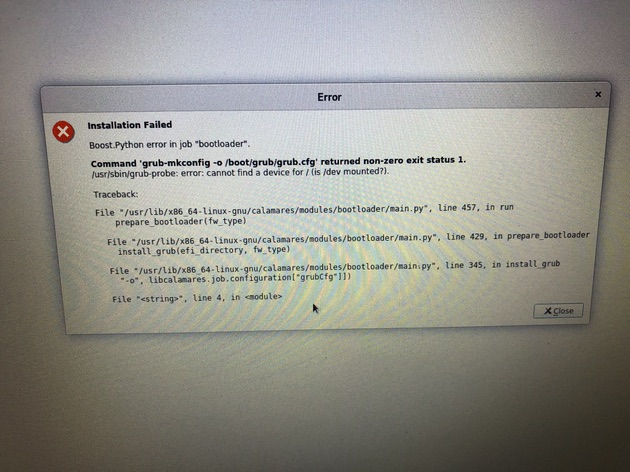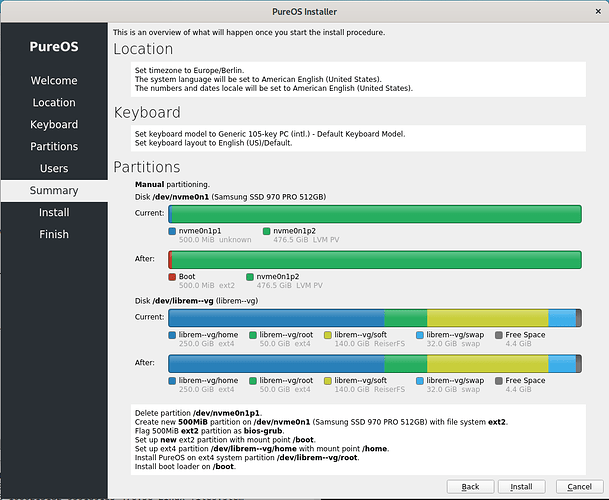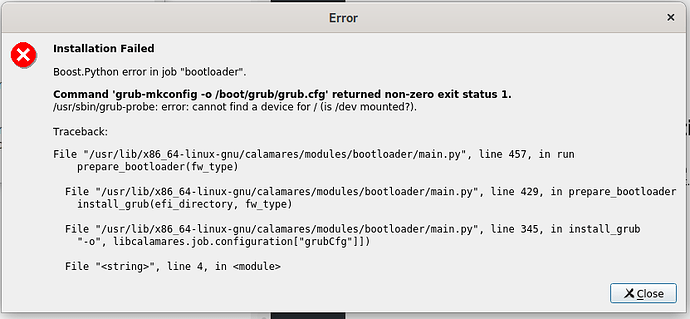I have a Librem15rev3 which has a 512GB Samsung SSD as the only disk. The default installation of PureOS creates one large disk partition for the system and the /home-directories, plus a small /boot-partition and a swap-partition (if needed).
I would like to do the installation using (encrypted) LVM volume groups for the /root- and /home, and additional (standard-non-LVM) partitions for /boot and swap.
I have tried several ways using the PureOS-Live-distribution on a USB-Stick, but the only thing that I managed to get working is the standard installation with one large partition for /home and /.
Funny thing is, my Librem15rev2 has an installation using LVM volumes, even encrypted, and it seems this was rolled out as a standard installation at the time. At least I do not remember that I had to do something sophisticated back then (most likely I just used the installer which sat on the second disk drive in that machine - and probably still is there).
So this is the configuration I have on the older laptop:
df
dev/mapper/librem–vg-root 48996512 38770904 7922532 84% /
/dev/mapper/librem–vg-home 257898948 207137668 37637696 85% /home
pvdisplay:
— Physical volume —
PV Name /dev/mapper/sdb5_crypt
VG Name librem-vg
PV Size <465.52 GiB / not usable 4.00 MiB
Allocatable yes (but full)
PE Size 4.00 MiB
Total PE 119172
Free PE 0
Allocated PE 119172
PV UUID AdeAp9-oN10-ullW-oSsz-spiE-J361-YQ3Hw6
lvdisplay:
— Logical volume —
LV Path /dev/librem-vg/root
LV Name root
VG Name librem-vg
LV UUID bdFQSL-wFqX-zx0r-OpgA-zEEn-xzWO-aAoesQ
LV Write Access read/write
LV Creation host, time librem, 2016-08-07 18:44:16 +0200
LV Status available
# open 1
LV Size <47.60 GiB
Current LE 12185
Segments 2
Allocation inherit
Read ahead sectors auto
- currently set to 256
Block device 253:1
— Logical volume —
LV Path /dev/librem-vg/swap_1
LV Name swap_1
VG Name librem-vg
LV UUID FXdBk5-JVWx-bVfR-0fg5-PqOb-Hq2u-qRQQG1
LV Write Access read/write
LV Creation host, time librem, 2016-08-07 18:44:16 +0200
LV Status available
\ # open 2
LV Size <15.92 GiB
Current LE 4075
Segments 1
Allocation inherit
Read ahead sectors auto
- currently set to 256
Block device 253:2
— Logical volume —
LV Path /dev/librem-vg/home
LV Name home
VG Name librem-vg
LV UUID 5SHVrR-le1R-wBop-6lWD-Ixw4-FlvY-GbcKZp
LV Write Access read/write
LV Creation host, time librem, 2016-08-07 18:44:16 +0200
LV Status available
\ # open 1
LV Size 250.00 GiB
Current LE 64000
Segments 1
Allocation inherit
Read ahead sectors auto
- currently set to 256
Block device 253:3
— Logical volume —
LV Path /dev/librem-vg/soft
LV Name soft
VG Name librem-vg
LV UUID 5JWmCP-4S3x-VG2d-T6F7-2KLW-l8nO-O5xjKc
LV Write Access read/write
LV Creation host, time librem, 2017-03-05 15:49:15 +0100
LV Status available
# open 2
LV Size 152.00 GiB
Current LE 38912
Segments 1
Allocation inherit
Read ahead sectors auto
- currently set to 256
Block device 253:1234:
But whatever I tried on the Librem15rev3, the installation process was always overwriting my LVM-partitions, or sometimes even crashing. There is a button for “Volume groups” in the manual partitioning menu, but I didn’t understand how it was supposed to work.
Any suggestions are highly appreciated.


